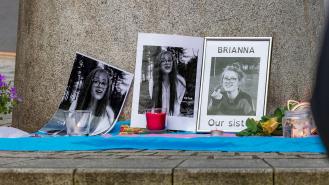
The double-murderer who terrified North London
On Crimes That Shook Britain, broadcaster Dermot Murnaghan is joined by a team of experts and witnesses to examine cases that gripped the nation to explore how they shaped public conversation. Series nine airs Mondays at 9pm on Crime+Investigation and features the terrible crimes of Kasim Lewis.
London is no stranger to violent crimes, but the atrocities committed by Kasim Lewis shook the city on a whole new level. Between December 2017 and February 2018, Lewis murdered two women and had the capital fearing the rise of a serial killer.
The victims
Moldova-born woman Iuliana Tudos was the first known victim of Kasim Lewis. The 22-year-old barmaid worked at the World’s End Pub in Camden Market and was reported missing on Christmas Eve after she failed to meet friends. Three days later, her body was discovered in a burnt-out building in Finsbury Park.
She had been bound with cable ties, a technique favoured by infamous murderer John Taylor, also known as the Killer in the Woods. During the ‘sexually inspired’ attack Lewis stabbed Iuliana multiple times in the neck, abdomen and wrists. A shape resembling a Batman symbol was carved onto her torso. He also obtained her PIN and withdrew cash from her bank account.
In February 2018, Lewis struck again. 55-year-old photographer and former civil servant Catherine Burke was found dead in her home in North London, bound, gagged and stabbed multiple times in the neck, stomach and back.
Police instantly recognised similarities between the two cases and were forced to consider the possibility of a serial killer.
The investigation
Forensic evidence played a critical role in linking the two incidents and prosecuting Kasim Lewis. His DNA was found on the bodies of both Iuliana and Catherine, as well as at both crime scenes. This armed police with the evidence needed to convict Lewis.
Lewis’s criminal background came into focus during the investigation and like many serious offenders, he had a history of violence. He’d previously served time for robbery and sexual assault, as well as indecent exposure on a public bus. Sadly, it took the lives of Iuliana and Catherine to put him behind bars for good.
The arrest and confession
Lewis was arrested in February 2018, shortly after Catherine’s body was discovered. He initially denied involvement in the murders but later confessed after he was confronted with steadfast forensic evidence. His confessions in police interviews were chilling and painted a picture of a cold and calculated killer with little remorse for his actions. Lewis recounted how he had stalked his victims and violently attacked them while high on cocaine, cannabis and alcohol.
The trial
The trial of Kasim Lewis was harrowing for the families of the victims and the wider community. Held at the Old Bailey, where notorious murderers like Babes in the Woods paedophile Ronald Jebson were also trialled, the court heard detailed accounts of the murders.
This included Lewis’s internet search history which revealed he’d searched for ‘granny sex’ pornography within hours of murdering Catherine. Before killing Iuliana he’d watched a graphic, violent pornographic video depicting a man chasing a woman into a dark alley and restraining her with cable ties. Strong forensic evidence was also used to support the case.
Lewis changed his plea to guilty and admitted to murdering both Iuliana Tudos and Catherine Burke. Prosecuting lawyer Crispin Aylett QC confirmed the guilty plea was in response to ‘overwhelming’ evidence against him.
This spared the families from the ordeal of a trial but did little to alleviate their grief. In a victim impact statement, Catherine’s son called the act ‘wicked and senseless’ and told the court, ‘There are simply no amount of words that can describe the sheer devastation this has caused me and my family.’
The judge handed down a sentence of life imprisonment with a minimum term of 40 years, describing Lewis as a ‘predatory and extremely dangerous individual’.
The aftermath
The Kasim Lewis murders didn’t just shake North London. They sent shockwaves across the entire country and brought to light issues like the need to more closely monitor violent offenders with previous convictions, as well as the importance of vigilant policing and community safety.
The critical role of forensic science in solving violent crimes was also front and centre during the trial. Despite Lewis’s confessions, the meticulous collection and analysis of DNA evidence was instrumental in linking him to the murders.







